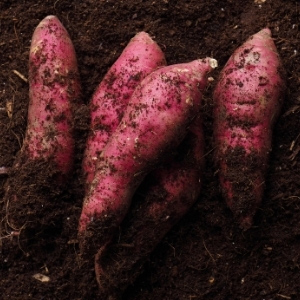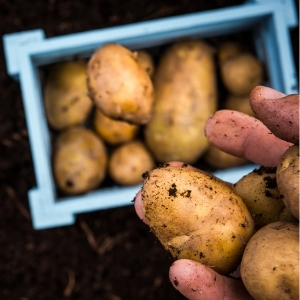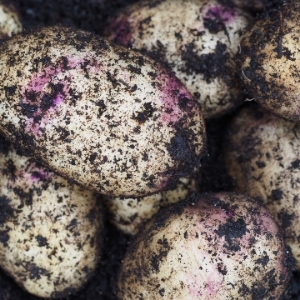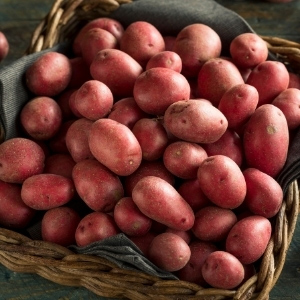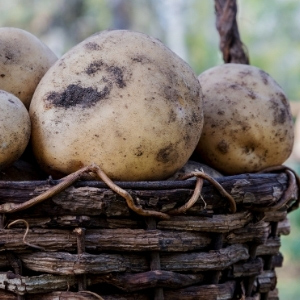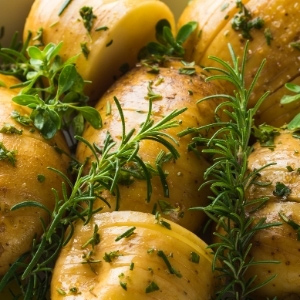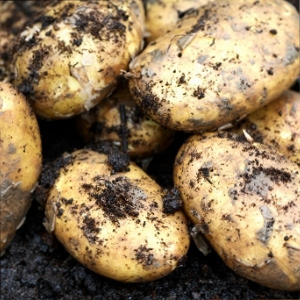Which potatoes to grow and when
Growing your own potatoes is easy and fun, but it’s important to choose the right variety. If you have limited space, simply choose a versatile seed potato that can be used for everything from chips, mash and roasties to tasty spuds baked in their jackets.
Want to expand your repertoire? Add sweet potato plants to the mix for an even wider range of health benefits. We stock an excellent variety of potato growing equipment to help you succeed.
How many different types of potato are there?
There are four main types of potatoes and they’re grouped according to when it’s best to plant and harvest them: first earlies, second earlies, maincrop and late-season potatoes.
What is a first early potato?
First early seed potatoes are commonly known as ‘new’ potatoes. This is because they’re the very first to crop in June. Taking just 9-13 weeks to grow, these smaller potatoes can be eaten boiled, steamed or sauteed. They taste delicious and have a white waxy flesh that’s perfect for salads.
Plant your first early seed potatoes between February and April ready to harvest through June and July. Plant at a depth of 10cm, 25-30cm apart and leave 45cm between rows. Open flowers (if present) indicate when you can start to harvest. This is usually within 12 weeks of planting.
What is a second early potato?
Second early seed potatoes are also called ‘new’ potatoes as they only take a few weeks longer to mature than first earlies. Ready to harvest within 14-16 weeks, second early potatoes are best planted between March and April and harvested from June to September. They can be eaten as new potatoes, boiled, steamed or sauteed.
Plant your second early seed potatoes at a depth of 10cm with at least 30cm between each potato. Leave 45cm between rows to give the plants enough room to grow and expand.
What are salad potatoes?
Salad seed potatoes are typically second early potatoes. As it says on the tin, these waxy tubers are particularly well-suited to potato salads for summer bbqs and picnics.
First and second early potatoes are known for their superior taste and texture, and there’s nothing quite like the delicious flavour of a new potato that’s eaten within a few hours of being harvested. Ideal for beginners, first and second earlies take up less room than larger varieties and, as they’re harvested early, they’re less prone to potato blight.
What is a maincrop potato?
Maincrop seed potatoes take longer to grow than first early and second early potatoes. Planted between March and early May, they take roughly 16- 22 weeks to mature and aren’t ready to harvest until late August through to October. If you want big yields of large, homegrown potatoes, maincrop is the type for you.
Plant your maincrop seed potatoes 10cm deep and 40cm apart. Leave at least 75cm between each row to allow plenty of space to grow. Open flowers (if present) indicate when the first tubers are present. This should take around 14 weeks from planting. The potatoes should then be left in the ground for 4 to 8 weeks to allow the skin to harden for better storage.
Maincrop potatoes are extremely versatile. Delicious mashed, boiled, steamed, roasted and baked, you can also use them for home cooked chips.
What is a late season potato?
Late season seed potatoes are commonly known as second cropping potatoes and are harvested in the winter from October until Christmas Day.
They’re grown from tubers that have been stored in a precise temperature-controlled room to keep them dormant until it’s time to plant them out in June and July. You’ll need to plant them as soon as they arrive so they can benefit from warm summer soil. Ready to harvest from October, if you protect your late season spuds from frost you can leave some in the ground until Christmas Day.
Are potatoes good for you?
Incredibly good for you, here are just some of the nutritious qualities of the humble spud:
- Boiled potatoes have the second highest concentration of folic acid after bread. Baked in its skin, an average sized spud contains over 30% of the Recommended Daily Allowance.
- Potatoes contain no cholesterol.
- Potatoes provide approx 15% of Britain’s Vitamin C intake. Rice and pasta provide none whatsoever.
- Potatoes are 72-75% water, 16-20% carbohydrate, 2-2.5% protein, 0.15% fatty acids, 1-1.8% dietary fibre.
- Potatoes actually top bananas in potassium content: a medium banana contains roughly 450mg, while a medium baked potato contains 750mg.
- One medium potato supplies, on average, 30mg vitamin C, nearly as much as in a glass of tomato juice, and 1.5mg iron, about the same amount as an egg.

